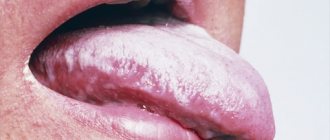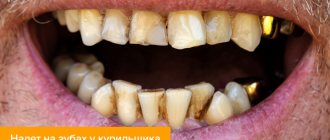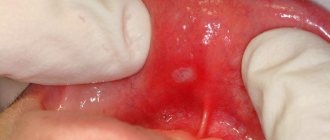It's no secret that smoking causes irreparable harm not only to the lungs, but also to other organs and systems of the body, and is the cause of the development of many pathological processes. The bad habit of “blowing smoke” very often becomes the cause of serious diseases of the oral cavity, namely stomatitis, also called smoker’s leukoplakia.
Stomatitis is an inflammation of the oral mucosa, therefore, in addition to smoking, other factors also play an important role: dietary habits (love of spicy, sour, hot foods), consumption of strong alcoholic beverages, taking certain medications, vitamin deficiencies, some allergic reactions, etc. Tobacco smoke destroys beneficial bacteria from the surface of the mucous membrane, the microflora is disrupted and stomatitis forms. Despite the fact that stomatitis is a disease that occurs in every second baby (of course, for other reasons), heavy smokers should not let the situation take its course, as this can be extremely dangerous. Therefore, treatment must be carried out in a timely manner.
Dentists at the Dudko and Sons clinic recommend taking the symptoms of stomatitis in adults seriously. Because if the irritating factor is not eliminated for a long time and proper treatment is not followed, the disease can transform into a malignant form. Tobacco smoke contains a large number of harmful substances: nicotine, tar oils, hydrocyanic acid, hydrogen sulfide, ammonium, carbon monoxide, phenols. Nicotine itself, when smoked, does not have a significant effect on the mucous membranes of the oral cavity and respiratory tract, but purine, which is formed during its destruction, is a very dangerous substance that has a high carcinogenic effect. Nicotine stomatitis occurs in 13% of patients with various dental diseases. Their refusal of treatment or failure to properly follow the doctor’s recommendations can lead to serious complications and even oral cancer.
Features of nicotine stomatitis in adults
Inflammation of the oral cavity, which developed as a result of regular smoking, has its own characteristics. Namely, the main focus of inflammation is located in the palate. This is due to the fact that when inhaling, it is the palate that suffers the most, falling under the stream of tobacco smoke. Fortunately, our body is designed in such a way that over time a protective mechanism is triggered - the normal epithelium at the site of chronic inflammation begins to be replaced by denser and rougher, keratinized epithelial tissue. However, such a defensive reaction does not always have time to develop. Often ulcers appear at the site of inflammation, which can be complicated by the addition of a bacterial infection. Inflammation can also spread to the gum mucosa and affect the salivary glands.
Smoker's stomatitis - why is it dangerous?
To date, there is no consensus on the mechanism of development of nicotine stomatitis. Of course, the tars contained in tobacco smoke settle on the oral mucosa, one way or another provoking its irritation. In this case, the body’s immune response occurs and inflammation develops. However, stomatitis does not develop in all smokers - the effect of accompanying factors probably also plays a role: dietary habits (in particular, a love of spicy, sour, hot foods), drinking strong alcoholic beverages, taking certain medications, vitamin deficiency, and some allergic reactions. Stomatitis is promoted by improper or insufficient oral hygiene, incorrectly installed dentures, as well as the composition of saliva (increased tendency to form tartar). One of the important factors contributing to inflammation of the mucous membrane is an imbalance in the bacterial microflora of the oral cavity, and dysbiosis develops not only as a result of taking antibiotics or using antibacterial pastes and rinses for dental care. Tobacco smoke, which is full of toxins, itself contributes to the death of beneficial bacteria that inhabit the oral cavity.
Features of nicotine stomatitis
As a rule, inflammation of the oral cavity that develops as a result of regular smoking has its own characteristic features. In particular, usually the main focus of inflammation is located in the palate. This is explained simply: it is precisely this area of the oral mucosa that receives a stream of smoke when inhaling a cigarette. Inflammation develops not only due to the deposition of resins, but also as a result of exposure to fairly hot smoke. Over time, the body tries to defend itself - the normal epithelium at the site of chronic inflammation is replaced by denser and rougher, keratinizing epithelial tissue. However, such a protective reaction does not always have time to develop - often ulcers appear at the site of inflammation, which can be complicated by the addition of a bacterial infection. Inflammation can spread to the gum mucosa and affect the salivary glands. Smoker's stomatitis is not classified as a precancerous pathology, however, it should be remembered that nicotine and tobacco tars themselves have a carcinogenic effect, and regardless of whether or not there is chronic inflammation of the oral cavity, the likelihood of developing cancer due to smoking exists.
Smoker's stomatitis: what to do?
Some people consider stomatitis a natural accompaniment of smoking and are convinced that it does not need treatment. This is a dangerous misconception. Chronic inflammation, especially if it is complicated by ulcers, is an excellent breeding ground for pathogens and the development of complications. Therefore, nicotine stomatitis can and should be treated, and to treat it, use drugs that have an analgesic effect and relieve inflammation, and also destroy pathogens. For example, the dental gel Cholisal® has proven itself well. When applied topically, the main active ingredient choline salicylate is absorbed through the oral mucosa, providing local analgesic, anti-inflammatory and antipyretic effects. It also has antimicrobial and antifungal effects (in acidic and alkaline environments). Cetalkonium chloride is an antiseptic that acts on bacteria, as well as fungi and viruses. The gel adhesive base helps to retain the active substances on the mucous membrane. Cholisal® is a triple-action dental gel for the treatment of inflammatory diseases of the oral mucosa (gingivitis, periodontitis, stomatitis) as well as for relieving pain during teething in children. Helps relieve pain, helps relieve inflammation, acts on viruses, bacteria and fungi.1
However, it should be understood that the main cause of nicotine stomatitis is a harmful habit that must be abandoned in the name of the health of not only the oral cavity, but the entire body. Stopping exposure of the oral mucosa to tobacco smoke in combination with treatment with a drug with anti-inflammatory and antimicrobial effects will have a beneficial effect on the condition of the oral cavity.
Artemova Oksana Aleksandrovna, dentist, Estet-dent, Moscow
_______________
1 Instructions for medical use of the drug CHOLISAL®
Treatment for stomatitis caused by smoking?
Some people consider stomatitis a companion to smoking and are convinced that it does not need treatment. Unfortunately, this is a dangerous misconception. When the disease passes into the chronic stage, it is complicated by the appearance of ulcers, and this is an excellent soil for the proliferation of pathogens and the development of pathologies.
Therefore, when a problem arises, most of us wonder how to treat stomatitis? First of all, you need to quit smoking, thereby allowing the palate to heal and become covered with healthy tissue. Under no circumstances should you let the situation take its course, do not self-medicate and see a doctor. It is imperative to carry out therapeutic treatment of the gums and sanitation of the oral cavity. You can use topical preparations and various gels.
Make an appointment or consult
Nicotine stomatitis (smoker's leukoplakia)
If you smoke, then your dentist has probably drawn your attention more than once to problems in the oral cavity associated with this bad habit. If you do not smoke, then this information will also be important for you.
When a dentist insists on stopping such a bad habit as smoking, this is due not only to plaque on the teeth (from gray to brown-black) and bad breath. Unfortunately, all therapeutic restoration work in smoking patients quickly loses its freshness, shine and takes on a dull, gray appearance. But a more serious problem is the development of nicotine stomatitis (smoker's leukoplakia) in smokers. Pathological tooth wear is one of the most pressing dental problems in our time.
Nicotine stomatitis is a protective reaction of the oral mucosa to the long-term toxic effects of tobacco fumes when smoking or chewing. Such stomatitis manifests itself in the oral cavity in the form of single or multiple foci of excessive keratinization of the epithelium (whitish films) against the background of chronic inflamed mucosa.
As a rule, patients with nicotine stomatitis do not complain. Sometimes they may notice a slight cosmetic effect in the form of white stripes or circles on the mucous membranes of the cheeks and tongue, roughness and dryness of the oral mucosa, and decreased taste sensitivity. Less commonly, there are complaints of burning of the mucous membrane when eating spicy or hot food.
When examining the oral cavity, the dentist discovers whitish films of various shapes that are not removed when scraped with an instrument. The favorite places for localization of films are areas of the mucous membrane that are subject to constant irritation by smoke, namely: hard palate, anterior
soft palate, corners of the mouth, back of the tongue. You can often see lesions in the form of white stripes on the mucous membrane of the cheeks along the line where the teeth meet. These stripes rise slightly above the level of the mucosa and are most often intermittent due to constant biting of the elevated areas. The patient does not feel pain; biting the cheek mucosa over time becomes just a habit and is observed in most patients. Against the background of white films, soft reddish tubercles with pinpoint openings of the excretory ducts of the salivary glands are often visible.
Diagnosis of nicotine stomatitis is not difficult for a specialist, but the success of treatment largely depends on the patient. If smoking is eliminated as the main cause of the disease, then changes in the oral cavity are easily reversible with treatment. If the long-term irritating factor is not eliminated, the disease can transform into a malignant form. Tobacco smoke contains nicotine, tar deposits in large quantities, hydrocyanic acid, hydrogen sulfide, ammonium, carbon monoxide, and phenols. Nicotine itself, when smoked, does not have a significant effect on the mucous membranes of the oral cavity and respiratory tract, but the purine formed during its destruction is a very dangerous substance that has a pronounced carcinogenic effect. Nicotine stomatitis is a facultative precancer and occurs in 13% of patients with various dental diseases.
When treating nicotine stomatitis, only eliminating a bad habit - smoking, proper treatment, sanitation of the oral cavity as a whole, and regular preventive examinations with a dentist give a good result. What is osteopathy in dentistry - read more in our dentistry blog.
Reasons [edit]
Nicotine stomatitis is thought to be caused by chemical or thermal keratoses. [3] Chemicals in tobacco may act as irritants in this condition. [2] Chronic heat exposure is also a cause. Pipe smoking causes more heat on the palate than any other form of smoking. This condition can also be caused by prolonged consumption of very hot drinks. The severity of the changes correlates with the frequency of the habit. [6] The prevalence depends on the society's consumption of hot drinks and smoking in various forms.
A similar but more severe keratosis of the palate occurs with reverse smoking. This is when the lit end of a cigar or cigarette is held in the mouth, another form of smoking that involves high levels of heat in the mouth. [6] This form of the disease is sometimes called "smoker's inverse keratosis", [9] and is a precancerous lesion. [4] [6] That is, the condition is associated with an increased risk of malignant transformation into oral squamous cell carcinoma (a type of oral cancer). Some sources do not distinguish between smoker's keratosis in reverse and smoker's palate caused by heat. [2] Thus, these sources tend to argue that nicotine stomatitis is a precancerous disease. [8] Some reports indicate that there is an increased risk of tonsil cancer, lung cancer, and posterior oral cavity tumors in people who develop nicotine stomatitis. [7]
Diagnosis[edit]
Diagnosis is usually made based on clinical presentation and medical history. [8] Tissue biopsy is usually not indicated unless there are areas of ulceration or localized erythroplakia (red spots). [8] Differential diagnosis with other causes of white lesions (see leukoplakia for a more complete discussion). Specific conditions that can produce a similar appearance include Darier's disease, [2] discoid lupus erythematosus, [10] oral candidiasis, [10] and oral lichen planus. [10]
If a biopsy is taken, the histopathological findings are hyperkeratosis and acanthosis. [9] There may be squamous metaplasia of the excretory ducts, resulting in visible papules if the ducts become hyperplastic. Neutrophils may fill some ducts. [9] It is characterized as "cracked" or "dried mud" due to excess production of keratin by cells. Dysplasia is rare. [9]
Links[edit]
- Rapini, Ronald P.; Bologna, Jean L.; Iorizzo, Joseph L. (2007). Dermatology: 2-volume set
. St. Louis: Mosby. ISBN 978-1-4160-2999-1. - ^ B s d e g h i J K
Scully S (2013)
. Oral and maxillofacial medicine: basics of diagnosis and treatment
(3rd ed.). Edinburgh: Churchill Livingstone. item 287. ISBN. 9780702049484. - ^ a b
Gnepp, Douglas R. (2009).
Diagnostic surgical pathology of the head and neck
(2nd ed.). Philadelphia, PA: Saunders/Elsevier. ISBN 9781437719512. - ^ B s d e Vellappally
, S;
Fiala, Z; Smejkalová, J; Jacob, V; Somanathan, R. (2007). "Systemic and oral diseases associated with smoking". Acta Medica (Hradec Kralove) / Universitas Carolina, Facultas Medica Hradec Kralove
.
50
(3): 161–6. DOI: 10.14712/18059694.2017.76. PMID 18254267. - ^ a b
James, William D.;
Berger, Timothy J.; and others. (2006). Andrews' diseases of the skin: clinical dermatology
. Saunders Elsevier. item 800. ISBN 978-0-7216-2921-6. - ^ B s d e e
Werning, John W. (2007).
Oral cancer: diagnosis, treatment and rehabilitation
. New York: Tim. paragraph 12. ISBN 9781588903099. - ^ a b c d
G. Taibos;
K Crews (July 28, 2008). "Changes in the mouth associated with tobacco use" (PDF). American Journal of Medical Sciences
.
American Academy of Oral Medicine. 326
(4):179–82. DOI: 10.1097/00000441-200310000-00005. PMID 14557730. S2CID 40189451. Retrieved August 31, 2013. - ^ B s d e e
Traister N. S., Bruha J. M. (2010).
Clinical Oral Medicine and Pathology
. New York: Humana Press. paragraph 46. ISBN 978-1-60327-519-4. - ^ a b c d e f g h
"Frictional, Chemical and Thermal Keratoses, from Bond's Book of Oral Diseases, 4th Edition". Maxillofacial Center for Diagnostics and Research. Retrieved September 1, 2013. - ^ a b c
Laskaris, George (2006).
Pocket Atlas of Oral Diseases
(2nd ed.). Stuttgart: Thieme. ISBN 9781588902498.
- Kahn, Michael A. Basic pathology of the oral cavity and maxillofacial region. Volume 1. 2001.
Treatment[edit]
When the onset is caused by heat, the lesion is usually completely reversible within a few weeks [7] if smoking is stopped. [4] [6] This is true even if the condition has persisted for decades. [9] Without smoking cessation, spontaneous remission of the lesion is unlikely. [2] If the lesion persists despite smoking cessation, it is usually considered true leukoplakia rather than reaction keratosis, [9] and may prompt the decision to perform a biopsy to confirm the diagnosis. [8] Because this condition almost always develops in the setting of long-term heavy smoking, it usually indicates the need for regular surveillance [8] for smoking-related cancers, such as lung cancer.











